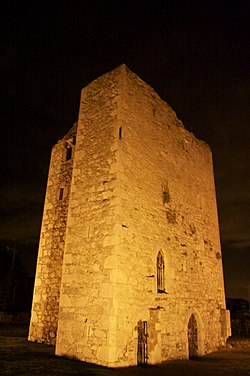Corr Castle
| Corr Castle | |
|
County Dublin | |
|---|---|
 The castle at night | |
| Type: | tower house |
| Location | |
| Grid reference: | SG27889593 |
| Location: | 53°23’24"N, 6°5’39"W |
| Village: | Sutton |
| History | |
| Built 15th century | |
| Information | |
Corr Castle is an L-plan tower house in County Dublin, which is likely to have been built at some time in the fifteenth century. It stands in Sutton, and within the boundaries of Howth Demesne in the old townland of Correston, close to the townlands of Quarry and Burrow.
The name of the place appears to be from the Irish Corraigh, meaning 'round hill'.[1]
The castle was probably built on higher ground in order to guard the isthmus at Sutton, which was the only route on land to access Howth Castle and the port of Howth.[1] It has historically sometimes been called The Dane's castle.[2]
History
It appears that the area surrounding the castle was inhabited by the Cornwalsh family in the Middle Ages, and it is suggested that they took their surname from the nearby hill, the Corraigh, and their Welsh origin. It is unknown whether the Cornwalsh family, the later White family or another party actually built the castle.
The castle was definitively owned by the Whites of St Catherine in the mid-16th century but passed to Christopher St Lawrence, 8th Baron Howth in 1579 and may have been improved and upgraded at that time.[3]
The castle mound was later used as a grandstand and feature on the Howth Park Racecourse (1829 - 1842) by the 30th Lord of Howth. The racecourse circuit ran from near Howth Castle and circled Corr Castle by the Burrow Road.[4][5] The Lord of Howth's black and white racing colours were later adopted by Howth Celtic Football Club upon establishment of the club on part of the Howth Castle grounds in 1962.[6][7][8]
The area around the castle was used as a quarry for much of the late 19th and early 20th century with the tower and out buildings along with a windmill water-pump some of the few structures left standing in the immediate area. More substantial remains of the castle can clearly be seen in photos taken by Francis Browne in the 1930s which appear to show part of external castle walls or a bawn.[9]
After being partially restored in the early 2000s, the castle is now secured and sits within a private apartment complex as an architectural feature although it still can be clearly viewed from the nearby Howth Road.[10]
The castle today
Among the identifiable features include the remains of a bawn wall, turrets, garderobe chutes - which could have had various uses over time, battlements and machicolations and a chamber with a corbelled roof. Although the tower has various defensive features, it is not clear that defence was the primary purpose of the building and rather functioned as a look-out tower and more as accommodation over time. Other more decorative features which have been recorded on the castle since the 18th century include a cut stone fireplace, pointed cut stone arch windows and a number of carved features including a bold chamfer with a defaced floral finial on the north-east edge of the main tower and a rude human face on a projecting stone on the East side.
Archaeological testing in the area immediately surrounding the tower has recorded evidence of habitation as far back as the 13th and 14th century.
Today the tower is well preserved and protected by virtue of its specific status. It now sits in a gated apartment complex with no new building permitted in the vicinity.
| ("Wikimedia Commons" has material about Corr Castle) |
References
- ↑ 1.0 1.1 Francis Elrington Ball (1979). A History of the County Dublin: The People, Parishes and Antiquities from the Earliest Times to the Close of the Eighteenth Century. Gill and Macmillan. ISBN 978-0-7171-0971-5. https://books.google.com/books?id=26ANAAAAIAAJ.
- ↑ The Journal of the Royal Society of Antiquaries of Ireland Fifth Series, Vol. 3, No. 4 (Dec., 1893). Royal Society of Antiquaries of Ireland. pp. 441–454 (14 pages).
- ↑ O'Laughlin, Michael (1999). The Families of County Dublin, Ireland. Irish Genealogical Foundation. p. 30. ISBN 9780940134300. https://books.google.com/books?id=wOaDfYPvE8UC&q=sutton+house+jameson&pg=PA30. Retrieved 12 June 2020.
- ↑ Hurley, Michael. Dublin Historical Record Vol. 59, No. 1 (Spring, 2006), pp. 65-80 (16 pages) Baldoyle as a Racecourse Village. Old Dublin Society.
- ↑ "Howth Park Racecourse". http://www.greyhoundderby.com/Howth%20Park%20Racecourse.html. Retrieved 12 June 2020.
- ↑ "Mission Statement". https://howthceltic.com/about-us-2/home-page/. Retrieved 12 June 2020.
- ↑ "Baldoyle Racecourse". https://www.rte.ie/radio1/doconone/2012/0702/647106-documentary-podcast-baldoyle-racecourse-horse-racing/. Retrieved 12 June 2020.
- ↑ The Sportsman. pp. 322–. https://books.google.com/books?id=zygGAAAAQAAJ&pg=PA322.
- ↑ "Corr Castle Photos - 1930". http://edwindavison.com/collections/shopdisplayproducts.asp?page=4&sppp=100&Search=Yes&category=1&atleast=corr%20castle. Retrieved 12 June 2020.
- ↑ "New Howth apartments have an old castle at the Corr". https://www.irishtimes.com/life-and-style/homes-and-property/new-howth-apartments-have-an-old-castle-at-the-corr-1.201912?mode=sample&auth-failed=1&pw-origin=https%3A%2F%2Fwww.irishtimes.com%2Flife-and-style%2Fhomes-and-property%2Fnew-howth-apartments-have-an-old-castle-at-the-corr-1.201912. Retrieved 12 June 2020.



